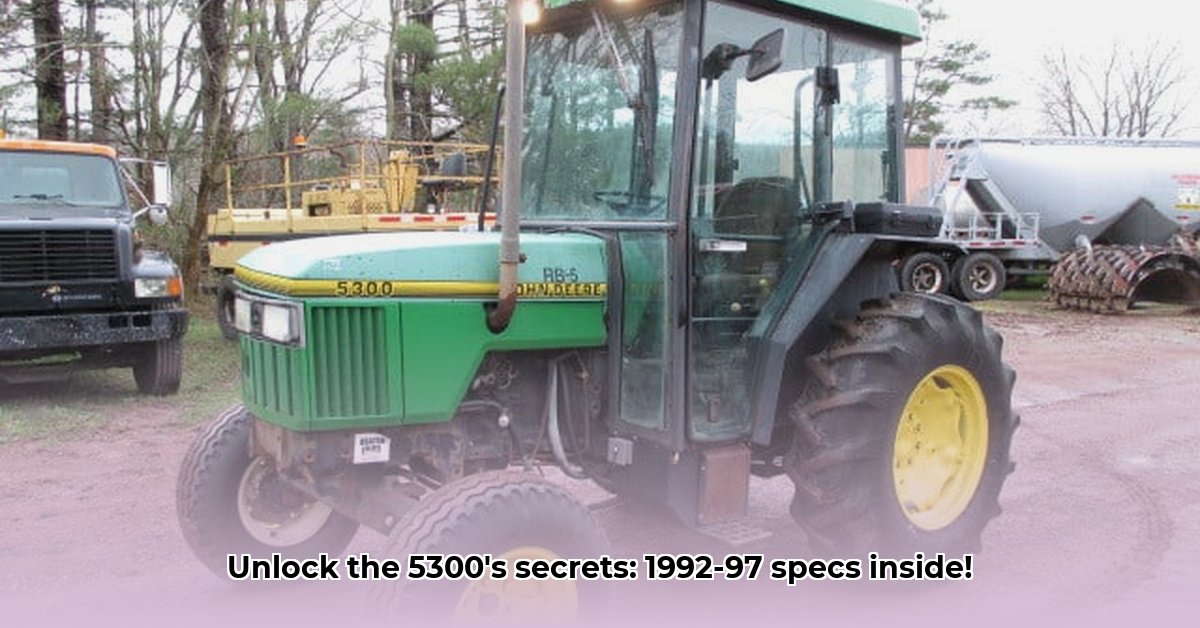
Engine and Powertrain Specifications
The John Deere 5300, manufactured between 1992 and 1997, featured a robust John Deere-built 2.9-liter, three-cylinder diesel engine. While commonly cited as producing approximately 55.9 horsepower (hp), variations exist across different sources. These discrepancies likely stem from differences in testing methodologies or reporting inconsistencies across different model years and regions. The fuel tank capacity is also inconsistently reported, ranging from 18 to 22 gallons. Precise fuel efficiency figures remain elusive due to a lack of readily available data in readily accessible sources. Further research into original John Deere documentation may yield more definitive information. This highlights the challenges of relying solely on aggregated online resources for precise specifications on older machinery. For more detailed specs, check out this comprehensive guide.
Transmission Options and Characteristics
The John Deere 5300 offered a choice of transmissions tailored to various operational needs. Buyers could select from a nine-speed unsynchronized gearbox, a nine-speed partially synchronized version, or a twelve-speed power shuttle transmission. Determining the precise gear ratios for each of these options proves difficult due to the inconsistency of available data. This inconsistency is likely due to a combination of factors, including variations across model years, regional differences, and the lack of comprehensive documentation available online. Accessing original John Deere service manuals would likely resolve many of these discrepancies.
Hydraulic System and PTO Performance
The 5300 utilized a standard open-center hydraulic system, common for tractors of that era. The system's typical capacity is listed as 10 gallons. Information regarding Power Take-Off (PTO) horsepower varies slightly across sources, fluctuating between approximately 50 and 50.67 hp. Again, the inconsistencies highlight the challenges of assembling a complete and consistent picture of technical specifications from disparate online sources.
Dimensions, Weight, and Cab Options
The 5300's dimensions and weight varied depending on several factors including whether it was configured as a two-wheel-drive (2WD) or four-wheel-drive (4WD) model, and whether a cab was included. A comfortable cab, equipped with air conditioning, was offered as an optional extra which, naturally, increased both the overall size and weight of the machine.
Performance and Typical Applications
The John Deere 5300 was a versatile utility tractor ideal for a range of applications on smaller farms and ranches. Its robust build quality allowed it to successfully handle various field operations, including plowing, tilling, cultivating, and light haulage. However, this tractor lacked the advanced electronic controls and sophistication of modern machines, offering a more basic and hands-on operating experience.
Comparing the 5300 to Competitors (Optional)
A comprehensive comparison of the 5300 against contemporary utility tractors from manufacturers such as Ford, Massey Ferguson, or New Holland is beyond the scope of this present article. However, such a comparative analysis would provide invaluable insights into the 5300's competitive strengths and weaknesses within its specific historical context. This would necessitate further research.
Parts Availability and Maintenance Considerations
For both collectors and prospective owners, parts availability is a critical consideration. The age of the 5300 means sourcing replacement parts may be more challenging. Proactive maintenance, including regular servicing and careful attention to areas prone to wear, is crucial to extending the tractor's operational lifespan. Obtaining certain parts may require sourcing them from specialized suppliers or online marketplaces dedicated to classic agricultural machinery. Given that finding certain parts might prove difficult, wouldn't it be prudent to prioritize preventive maintenance?
Conclusion: The John Deere 5300's Legacy
The John Deere 5300 represents a significant piece of agricultural history, serving faithfully throughout the 1990s. While assembling a completely consistent set of specifications from available online data proved challenging, this article has highlighted the key characteristics of this versatile workhorse. The accuracy of this information would be improved by access to official John Deere documentation. Owners and prospective buyers should consult original service manuals and other manufacturer literature for the most accurate, complete, and verifiable information.